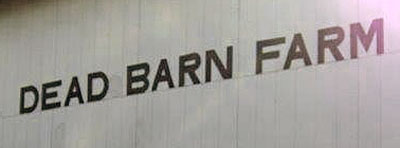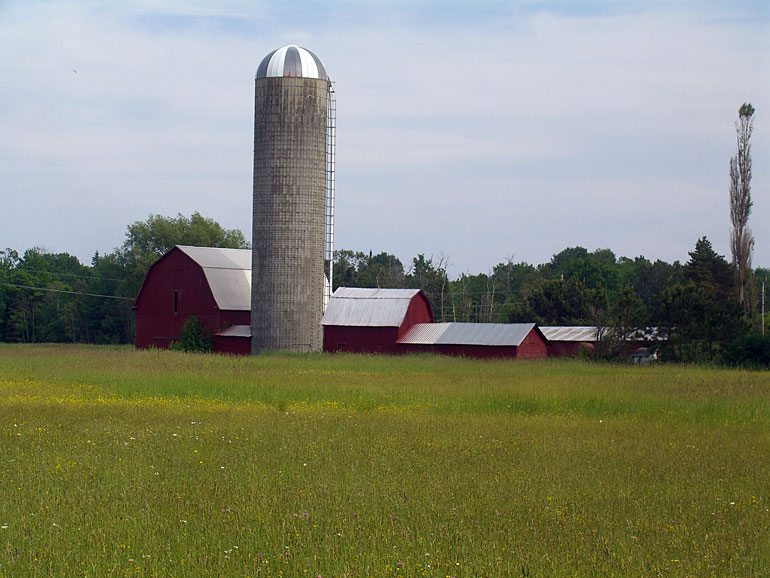It is the People Who Make Barns Special
You are never quite sure what to expect when your job entails knocking on strangers’ doors, especially if you are selling vacuum cleaners, promoting driveway sealer, or offering religious tracts.
Thank goodness one of my current assignments as a writer requires none of the above except the knocking-on-doors-part. Fortunately, in the nearly two years I’ve been doing it, no one has slammed a door in my face or even been the least bit unkind. No doubt it has everything to do with the fact that I have come not to sell but to learn.
I prepare a feature for Michigan Farmer magazine, titled “Mystery Barn.” Each month, readers can guess the location, based on a photograph of one Michigan barn while learning something about the barn that appeared in the previous month’s edition. People love to talk about their barns and in doing the feature, I have met fascinating folks, photographed unusual barns, and heard intriguing stories about why particular barns have special significance to their owners.
An afternoon of “barning” in the UP’s Mackinac County, back in late August is one that will linger fondly in mind for a very long time.
I stopped at a farm in the early afternoon and was greeted cheerfully by a pretty white-haired lady I guessed to be in her mid-70s, just as she was heading to apple trees near the house. “I’ve got to get my apples just at the right point of firmness to work with my mechanical peeler,” she explained. After learning the reason for my visit, she was delighted to cooperate but said her husband was napping. I offered to stop back later. Delightedly, she said that would be just fine.
Off I went to the next barn, one I had been drawn to because of the quilt block painted on its south end. But it was the name, “Dead Barn Farm,” painted on the east side of the white barn that grabbed me. I had to know more.

The owner, a too-thin man I would guess to be in his late 60s, greeted me with enthusiasm and invited me to join him on a shady deck bright with many pots of flowers.
It was a humid day near 80 degrees so when he offered me a drink I accepted, not expecting it to contain whiskey. He assured me he had made it “light” so as I politely sipped my beverage and jotted notes, he told me how his property came to be known as Dead Barn Farm.
It seems that a friend from Florida had visited one November to do some deer-hunting and, in the heavy early morning fog, his gloved hand slipped as he was handling a 45-calibre muzzleloader, sending a shot through the back wall of the barn.
The man laughed as he said his wife had called him at work, explaining, “You’d better come home and help drag in your friend’s kill. It’s pretty big.”

After still more stories of the barn, this man has maintained out of both fondness and function, we talked about early settlers and apple trees, country living, and life’s twists and turns. Now and then, his eyes clouded with emotion.
After snapping some photos I prepared to leave. He extended his arms to offer a hug. With an invitation to return, I went on my way with a gift of a bag of yellow Transparents from one of the many wizened trees on his farm.
As I hurried back to the first farm, it dawned on me with some alarm, that I was about to show up to do an interview with whiskey on my breath. There had not been enough alcohol in the drink to have any physical effect except quite possibly, on the couple’s impression of me. It had been years since I’d had anything stronger than beer or wine. What would they think of this person who called herself “the Barn Lady”?
The couple at the first farm was waiting and watching as I arrived. I had photographed their barns from the road, captivated by the layout of the traditional gambrel-roofed barn, outbuildings and a silo that seemed to reach all the way to heaven, set against a golden field. As I reintroduced myself, I quickly ‘fessed up about the reason for the whiskey on my breath.

As surprised as I had been about being served whiskey, I was even more surprised by what happened next. Without batting an eyelash, the petite farm wife set a steaming bowl of “Rainy Day” vegetable soup, a thick slice of homemade bread, a jar of her special strawberry rhubarb jam, and a cup of black coffee in front of me. “We’ve got to sober you up” she giggled as her husband, seated across from me at their old oak kitchen table, watched and grinned.
The first bowl of extraordinary soup and slice of scrumptious bread disappeared quickly and she was instantly back with more, followed by fresh homemade donuts and then, a delightful taste of homemade choke cherry wine. As I put the glass to my lips her husband chortled, “We have sobered her up only to give her alcohol all over again!”
Such was the start of two of the most body-nourishing, faith-in-mankind-renewing hours I have enjoyed in a very long time. We talked about the couple’s barn and its meaning to them, built on land homesteaded by his grandfather. But even more, as we visited, I had the privilege of observing two people married 59 years interact with respect for one another, exuding total conviction about what brings meaning and joy to their lives and unabashed faith in the power of prayer and importance of family. And all the while, she scurried about the kitchen, peeling apples with a clever little gizmo, dropping them into canning jars filled with fragrant, spicy broth for ready-made pie filling. Quarts of beans canned earlier, cooled on a counter. Cabinets in another part of the house were bright with jars of fruits, vegetables, and preserves.
“I prayed to God as a young man to give me a good wife who could cook,” the man said slowly and deliberately. “Look what I got!” If feelings can be written all over one’s face, love and admiration were spelled out on his in glowing capital letters.
 The couple has four children, 20 grandchildren and 26 great grandchildren many of whom gathered last summer to paint
the farmhouse and to split and stack firewood for the winter. A photo album documents in image after image, each of the
quilts the pretty lady has made by hand for each member of the tightly-knit family and several friends.
The couple has four children, 20 grandchildren and 26 great grandchildren many of whom gathered last summer to paint
the farmhouse and to split and stack firewood for the winter. A photo album documents in image after image, each of the
quilts the pretty lady has made by hand for each member of the tightly-knit family and several friends.
Although the couple farmed until 2000, farming was never his first choice of vocation. He worked for a carpenter for a time and so enjoyed creating fine things of wood he became a master cabinetmaker. His work has found its way all across the country.
“I remember when this road – named for my grandfather – was little more than a trail,” he remembers. “And there were Indians here.” His maternal grandmother was part Indian though he does not recall to which Michigan Native American nation she belonged.
A tremendous source of satisfaction for this farm couple is their co-authorship of a book one of their daughters is helping them to publish. Titled, A Life Worth Living, the book shares the story of their lives from courtship, including tidbits of some 250 love letters all of which still exist, to marking 60 years of marriage.
As evening shadows fell across the side of the big red barn creating patterns on the silo, the pretty lady packed me off with a container of soup, a loaf of bread, a bag of donuts, and a bouquet of freshly cut hydrangeas. We shared hugs.
“Come back,” she said, “Come back and see us again.”
I promised I would, minus the whiskey on my breath of course.
I knock on doors to learn about wonderful barns but in the process, I also learn about wonderful people. Both are good for the soul.
Jan Corey Arnett©2014
* The Engadin or Engadine (German: Engadin, Italian: Engadina, Romansh: Engiadina, French: Engadine; tr: garden of the Inn) is a long valley in the Swiss Alps located in the canton of Graubünden in southeast Switzerland. It follows the route of the Inn River from its headwaters at Maloja Pass running northeast until the Inn flows into Austria, one hundred kilometers downstream. The Engadin is protected by high mountains on all sides and is famous for its sunny climate, beautiful landscapes, and outdoor activities.
Copyright © Coralan Communication. All Rights Reserved.
Cory Computer Systems
